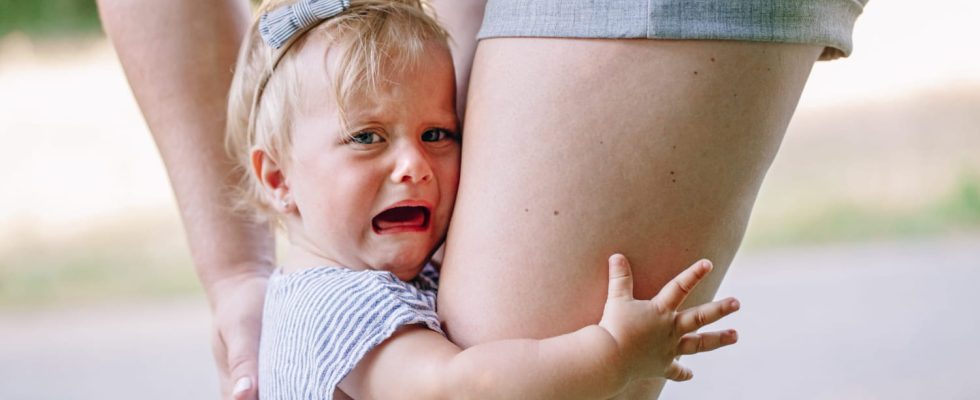Your baby sticks with you all day long, he only asks for the arms of his mom or dad? He is surely in the crampon period. A step that is positive for its development. At what age does it occur? How to explain it and what to do? Answers with Anne Raynaud, psychiatrist.
During the first year of life, most babies go through what is called spike period. During this phase, baby will constantly claim the arms of his mom or dadand stick to its parent, much like a baby koala. However, this phase brings a lot to the child, in particular to gain in confidence and autonomy. How to react during this period cramp? Advice and explanations from Anne Raynaud, psychiatrist.
What is the crampon period?
We are talking about spike period when you can’t put your baby down for two seconds without him crying. He always wants to stick with us. A normal phase according to psychiatrist Anne Raynaud. “One of the fundamental needs of the child for his development is the need for emotional security, yet he goes through a great closeness with the parent”.
Consequently, the child is more “crampon” with his main attachment figure, that is, the parent who most often takes care of him, comforts him, gets up at night when he needs. It is his landmark and he clings to it. For the expert, the baby is like a small plane placed on the deck of the aircraft carrier (its parent) and at the beginning, it needs to come and land there often to refuel safety, then go explore, take off from the aircraft carrier and back. Then, growing up, the toddler will take off, he will need less and less of his aircraft carrier.
“One of the fundamental needs of the child for his development is the need for emotional security, and this requires a great closeness with the parent.”
At what age does the cramp period begin in children?
“The child particularly feels the need to be close to his parent first year of his life“, says the expert. Preciselythe crampon period usually occurs between 3 months and 9 monthswhen the child identifies his attachment figures. “It is for this reason thatat 9 months, the child is afraid of strangers, because he also perfectly identifies people who are not his attachment figures”details the psychiatrist.
How long does the cramp period last in babies?
In principle, the crampon period lasts until the child knows how to move around on his own and can explore his environment freely. This phase usually ends after the child is 9 months old.
Why is this cramp period important for the child?
In the first year of a child’s life, wanting to cling to his parent is good for the baby’s development. He has some need to grow well, fill up on security and then go explore the world. “This closeness reassures him, gives him confidence and helps him build his confidence in himself and in others”, analyzes the psychiatrist.
However, some babies, especially BABIs (high needs babies) have a greater need for security than others – and therefore proximity – while others need it less. “It’s a question of temperament and genetics”, she details. By granting our child this closeness, we help him to blossom and develop his inner resources. Especially if he is cared for during the day in a crèche or at the nanny’s, he will be reassured to see that we are available for him the rest of the time.
“Once this need for emotional security is met, they will be more confident, empowered and will explore much further.”
Even though it can be exhausting at times to hold your baby in your arms all the time, the psychiatrist advises parents not to push their child away. For what ? Because certainly the child will become autonomous much faster, but will explore less far. Conversely, “the more we are there for him the first years, and especially the first, the more easily he will come off afterwards, because he will have full confidence in himself”, she points out.
Of course, sometimes you can’t help but put it down, to take a shower, for example. In this case, we reassure him and explain that we will be back. Gradually, he will understand that it is not because you move away for a moment that you will disappear.
We also do not hesitate to entrust it to the other attachment figurebecause as Anne Raynaud points out : “when the child identifies his main attachment figure, he does not see the other attachment figures, but if we entrust him to the dad, the nanny or the grandparents, he will identify that he is always safe”. Moreover, the more the other parent gets involved, takes care of the change, the bath, the bibi or the comfort, the more baby will realize that he actually has two parents available. His needs will thus be better distributed and he will no longer cling to just one parent.
